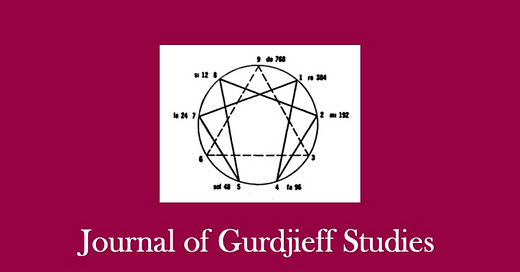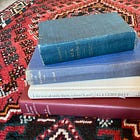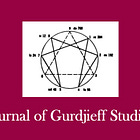Here are the newly organised contents of Part 2, with summaries of articles and links. These, together with Part 1, are also the contents of the newly published Volume I of Journal of Gurdjieff Studies, which has extensively rewritten articles:
See also:
Please note that articles assume familiarity with fundamental fourth way texts. See Introduction and Bibliography for guidance.
See also:
A) General and Miscellaneous Considerations, Hypnotism and Consciousness
An approach to “Gurdjieff’s Medicine.” The importance of looking after the body as the basis for it being a good servant. Nature as helper. The uses of the denying force. Gurdjieff’s dentistry. Some hypnotic considerations. Burns, and a first look at intentional suffering, in terms of fire. What about cancer?
2.1a – Medicine is a branch of cooking – “How can we think of Gurdjieff? As a musician? Choreographer? Writer? Physician? Psychiatrist? Master Cook?” - Zuber
2.1b – An Introduction to “Gurdjieff’s Medicine” – the relation of Gurdjieff’s medicine to his teaching as a whole; the problem with collecting fragments; the universe being composed of vibrations; the law of seven; the law of three; the unity of everything; the materiality of everything; improvement in health in association with self-development; the idea of normal.
2.2 – Nature Will Help You – To work and to get out of the way; health only as a side effect; the taint of reform; the best conditions for work, and who should change them?
2.3 – Can One Will Health? – Will and delight; an anti-identification device; using the denying force.
2.4 – The Clever Wolf - Wolf must not only be full but satisfied; better to leave damaged than interfere; indirect effects of work on the functioning of the instinctive centre; willing the wolf.
2.5a – Gurdjieff and Teeth – Literal or allegorical or both?; “Orange cleans the sticky sweet.”
2.5b – The Ins and Outs of Chewing – Gurdjieff’s lack of qualified dental treatment as a child; Gurdjieff as a young man told not to chew too much; canine teeth and vegetarianism; chewing keva; chewing ideas.
2.6 – Georgette Leblanc and Health as the First Requirement – What was the secret that Georgette Leblanc gained from Gurdjieff that so transformed her physical health as well as enabled inner work for being?
2.7 – Slugs, Worms and Slipperiness – Section 1 and Section 2 – An initial look at the psychology of parasitology and the denying factor in the teaching of Gurdjieff.
2.8a – One Centre Hypnotising Another – Although usually only unconsciously hypnotic, through conscious self-suggestion, intentional contact can be made between the different parts of the human being, as described by Gurdjieff.
2.8b – Conscious Autosuggestion between the “Individuality” and the Body – Bringing about a contact; first to relax; connecting the centres.
2.9a – Waking up in the Morning and Harmonious Concentration – What is it about the morning, and the time just after waking up, that is apparently so important for inner (and perhaps outer) work?
2.9b – Harmonious Concentration – Waking Up the Centres – Better concentration in the morning; waking state dependent on prior sleep; cold water and gymnastics; imaginary fatigue; necessity for relaxaton or tension?; the hyper-suggestible state on waking from sleep; a state of possibility and of danger.
2.10 – Hypnotising into and out of disease – Suggestion and illness; respiratory function linked with emotional states; mixture with personal elements or not; how the three centres may be linked up.
2.11 – Burning – Fighting fire with fire; the potential for misunderstandings; strange combinations of fire, pain and fury.
2.12 – The Fire of Consciousness – The dynamo; bringing everything inside you; the need to keep the inner fire burning; the ferment of personality; increasing the fire of consciousness; the wrong kind of fire.
2.13 – Healing Fire – I – Going back to the fire; intentional contact between inner and outer world; healing the body; manipulation of attention.
2.14 – Healing Fire – II – Continuation of an examination of intentional suffering in relation to healing; looking especially at how attention may change the body; activation of emotion; the idea of suffering “intension”; increasing the appetite for fire; the relation of intentional suffering and love.
2.15 – Gurdjieff and Cancer – The power of suggestion; “the science of vibrations”; flowers.
B) Series on the Prolongation of Life
A subject repeatedly present in Gurdjieff’s writings and talks. Looking at economising experiences lengthening life and intentional suffering regulating health. Orage’s role helping us to understand intentional suffering.
2.16 – On Living Long Enough – The death of Orage, and Gurdjieff’s principle of regulating health through intentional suffering. The question is posed: How can intentional suffering restore health? This question then permeates a number of further articles on intentional suffering.
2.17 – Death during this life – Objective drama increasing “the productivity of the perception”; swapping sufferings; guarding against double dealing; part of a template?
2.18 – Some thoughts on the Difference Between Voluntary Suffering and Intentional Suffering – Looking further at the possible significance of intentional suffering, with especial reference to the relationship between Gurdjieff and Orage; inconsistencies in the records throwing us back on our own resources; willing suffering; increasing the longing; intentional contact; a certain kind of wishing as suffering; what kind of sheep?
2.19 – Muddling and Befuddling – A deliberately labyrinthine tale? The connected renewal of two parts; protecting these ideas; was Orage (or were his pupils) being set up?; more inconsistencies; the need for patience and sweat to prevent prematurity.
2.20 – Prolongation of Life – Sacrificing Suffering – Sacrificing mechanical suffering; relaxing and preventing negative states; wrong suffering and imagination; developing attention and prolonging life.
2.21 – Economising Experiences – “Man is given a definite number of experiences—economizing them, he prolongs his life.” What does this mean? Perception of impressions and the construction of the receiving apparatuses. Experiences and the possibility of receiving new impressions.
2.22 – Proving the Moment – Continuing the question of: What is an experience in Gurdjieff’s terminology? Experience and proof – playing with words: proving dough as an analogy for enlarging the moment in our consciousness; entering the unknown of the new impression and the increase of self-awareness – the fire of simply staying there; “staying in front”; remorse and repairing the past; the past is contained in my brain and body; to repair the past by repairing associations through remorse is preparation for the functioning of associations in the future; the moment can hold one’s whole life.
2.23 – Opening to Experience – Experience seems to be about the combined process of the receiving, fixing and replaying of impressions; laying oneself open to experience; the curse of the “Imaginary I”; the ordering of the fixing of new impressions; the furnishing of centres; saving time by depth of experience; slavery to events or being here now.
2.24 – Enlargement of Time and Being – continuing with the question of “economising experiences,” together with the link between time and awareness; time and state; the tempo of the flow of associations; the paradox of time; “I am time”; the unwinding of the springs.
2.25 – Timely Connection – Can work on attention also influence the life of the physical body? Going from one side of oneself to the other; the idea of the “Time-body” and its potential effect on the physical body; connecting mind and body; the spiritualisation or the tyranny of matter.
2.26a – Enormous forces are locked up – A treasure casket of locked up forces; applying the key; "unwinding" and involution, "winding" and evolution.
2.26b – An Unfortunate Place to Be – Using the energy of being in a “bad” place; the advantages of not being given a legacy.
C) Meat and Vegetables Series
Links between vegetables and consciousness, starch and the soul. Revisiting the cerebellum; the seed at war. Meat and mentation. The surprising possibilities of fishes.
2.27 – Greens and Mentation – Respect for vegetables; making active mind; help for transformation.
2.28 – Further on Greens – Growing, Quickening and Aiding the Animation – Greens and quickening; the possibilities of vegetation; “important for Okidanokh”; only vegetables on Mars; the sensitive film of organic life – what is the equivalent for the body?; “the seed at war”; the black clay of the cerebellum; the germ of the real “I,”; establishing “vegetable” life; the vegetative nervous system; Polormedekhtian-arisings; green tea and the animation of the whole of oneself.
2.29 – “Starch Gives Everything” – Divine starch; potatoes and butter; rice and the importance of eating yoghurt with it; wheat and the sacred significance of bread; only “prosphora” eaten on Mars; active elements just under the husk; a certain attitude; “digestion is transformation.”
2.30– The Meat of the Matter – Meat and vegetable stews for every day; no frozen meat; English mentation; fruits of fantasy.
2.31 – Some Health Advice from Ouspensky: Too Much Meat – Feeling heat and thirst; but meat necessary when there is hard physical work and cold.
2.32 – Blessed Fishes – I – Trout and butter; “what he have specific under skin”; trout only happy in a difficult place; a special meaning for “spoiled,” and the harrowing of hell? active elements accumulated through struggle; the “fish” diagram; Purgatory, the heart, conscience and the nibbling of the trout; thorns; “Leaping-alive.”
2.33 – Blessed Fishes – II – The squirming sardine and the approach to struggle; ; fat vibration when high up – divine music; choosing the difficult places in the mountains; butter, ambrosia and nectar.
2.34 – More and More Fishy – A Pied Piper for fishes.
2.35– “How Deep Was Water”? – Fishing in unusual places; a talk on faith; entering a different sphere; dangers and possibilities of jumping into water; special organs are needed; diving for the chaplet, and its possible connection with the “fish” diagram.
D) Sweetness, Bitterness and Magnetism
This section looks especially at the significance and contrast between sweet and bitter things, literally and allegorically, and about the role of “magnetism.” It begins with a couple of “sugar articles,” followed by a connected series of posts on the story of Thomas and Olga de Hartmann’s time with Gurdjieff and his other followers between 1916-18. Their reported experiences of these early years with Gurdjieff are used for their allegorical potential in representing certain important themes in Gurdjieff’s teaching, as well as to look at some of the literal details, or, rather, hints, of Gurdjieff’s healing practices.
2.36 – Sugar and Monsieur Bonbon – Gurdjieff says that sugar is cheap. Yet he gives out plentiful sweets, especially to children, which cost him a lot.
2.37 – Sweet and Bitter – Sweet things become boring after a short while; roses need thorns; sugar is “By the way”; to choose thorns for the sake of future good; leisure and rest; “Sweet you must not like, you must use”; the temptation and danger of reward before work.
2.38 – A Sweet Tooth – Thomas de Hartmann had a very sweet tooth; Gurdjieff warns him about getting “sugar-disease”; Hartmann insists he did not mean diabetes by this; Gurdjieff tells him, “You must not eat sweets”; the production of an inner struggle with a strong habit; after a gruelling expedition, they arrive in the “paradise” of Uch Dere, with the largest roses Hartmann had ever seen.
2.39 – Pears and not Plums – The next stage; thorns; a warning and “forbidden fruit”; Gurdjieff warns against the sweet plums, whose pit comes out easily; wild pears are favoured – they are sweet only when ripe.
2.40 – Typhoid and Near-Death – Hartmann storing up certain forces that helped later to fight his disease; moving into a house submerged in enormous roses, but nearly unconscious, and “this paradise of beauty has remained associated ever since with an unbearable headache”; confined to bed, he loses consciousness and memory for a prolonged period; the hero of a fairy tale – receiving help from unknown sources; yet, temptation has caused a fall.
2.41 – Red Musical Notes – The “sweet” life of Thomas and Olga de Hartmann – but meeting Gurdjieff, it was as if they swapped roses for thorns; “love is the strongest obstacle to man’s development,” “But what kind of love?” Evil red notes, and being delivered from them by a simple peasant girl.
2.42 – A Magnetic Path – “My life became a sort of fairy-tale”; magnetism as guide and as medicine; a magnetic bond; animal magnetism, being-hanbledzoin and healing.
2.43 – Magnetic Cure – “Setting yourself a voluntary aim and compelling yourself to achieve it”; magnetism and attention; magnetism as a substance, or, rather, mixed substances; “sick persons have not enough mixed substances”; injection of camphor; black and white things; when Hartmann is himself again, he can have sugar; a new kind of gladness; sweet things that before were cheap are now expensive; justness to body; not to use this force in life.
2.44a – Sugar Placebo? – The psychological aspect of cures; conditioning and deconditioning of associations; decreased consciousness and confusion as a “fall” or a necessary transitory state?;.
2.44b – The unfinished house and being a law unto oneself – sacrifice only for a certain time; the pear tree.
2.45 – Magnetism and Love – Looking for direction; the problem of sentimentality; love and remorse; the basis of all; accumulating vibrations.
2.46 – All Life Needs Love – Nature as doctor; the connection between love and attention; is the human being more sensitive to love than animals or less sensitive?; help from above; “do I know what is good for people?”
2.47 – Self-deceptive Imaginativeness – Between magnetism and love lies imagination; you must not believe; making data for inner vision.
E) Aspects of the Food-Factory
From magnetism to will. The question of the heart. The struggle of the seed. The dangers of the fifth step; Kundabuffer, hypnotism. New birth. More scheming?
2.48a – The human organism as a three-storey factory – A basis.
2.48b – Under the Power – Beginning with the end in mind; union through will or through identification; wrong use of imagination and the two bloodstreams; care needed at the fifth step; the paradox of non-identifying with something and willing that same thing; intentional relaxation as a help for freeing from identification; willing what is and self-remembering; how to relate Sol La Si with Do Re Mi of the same vibration density?; applying will to impressions; reducing the Second Force.
2.49 – The Fifth and Sixth Step of the Transformation of Food, and the Question of Exioëhary – The creation of forms; law-conformable confusion?; where is the heart?
2.50 – At Sixes and Sevens – The energy of dissatisfaction necessary for persistent pursuit; the final product of the transformation of food in the human organism; “seed” or “fruit”; a working principle.
2.51 – Transition to the Next Octave – Numbering and sequence; the possibilities of new birth; the need to obstruct the acquiring only of mental knowledge.
2.52 – Continuing the Pursuit of the Missing Link – Some Atlantean Possibilities – Consciousness and conscience; higher centres and confusion of terminology; what is it “to work with” certain substances?; the submerging of conscience and essence; the possibility of the uniting of personality and essence through conscience.
2.53 – The Sinking of Atlantis – The dividing of the waters; consciousness and subconsciousness; combinations of integration of centres; becoming “compassionate,” and “sensitive,” a possible connection with “Trnlva,” and feeling and sensing; the hypnotic state and Kundabuffer; what are the factors that engender the impulse of conscience?
2.54 – Hydrogen 24 and the Heart – What does the “subconsciousness” consist of?; being-Exioëhary at the sixth or seventh step? – evidence for and against; Daly King's “mistake”; the search for direction and for conscience; Daly King's combination of the “fish” diagram and the substances of the three-storey factory; a sequence of symbols; Purgatory, conscience and the heart.
F) Air, Climate and Emotions
The connection between air and emotion. The ongoing question of, What really is a negative emotion? Passivity in the wrong place. The search for real emotion. Literal and figurative aspects of climate, and its relation with emotion.
2.55 – The Transformation of Air, Our Second Food – Disorganised right functioning; dangers from books; the cause of many illnesses; the need for right connection, energy and continuous functioning.
2.56 – The Normalisation of Functions – What is a function?; wellness and the struggle of functions; the function of emotion and respiration; identification inhibiting the normal digestion of air; the term negative emotion; passivity and dysregulation in one-centred functioning; returning to sensing the body.
2.57 – Sacrificial Offerings and the “Yes” and “No” in Oneself – What kind of sacrifice?
2.58 – Thoughts on the Impulse of Revenge – A personally meaningful encounter, not without its humour; finding another aspect of inner fire.
2.59 – A Purifying Factor or the Eighth Deadly Sin? – Despair and despondency – is there a difference?; controlled or uncontrolled energy; being reduced to essence; a new atmosphere.
2.60 – Reflections on Sourness – Depression not a negative emotion, but may be caused by one; the need for its recognition; “waterlogged centres” and sour energy leading to the need for effort, even the smallest; remembering oneself and being lifted out of depression; understanding such states to be able to work on them in the right way; letting go of false pictures during the process of disillusionment; to non-identify with the inner state and to become inwardly active.
2.61 – “This illness called an English winter” – What is the problem – cold? damp? less light? psychological damp and frozen mentation?; quality of the second being-food; what is the cure for this English disease? – inner heat? listening to the messages of Nature?; the requirements of the middle laboratory; enjoying the rain.
2.62 – Further on Inner and Outer Climate – More on dampness; directing the climate; emotional climate and protection from its vagaries – sensing the body, internal heat and light, laughter.






